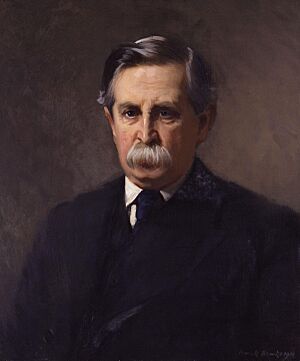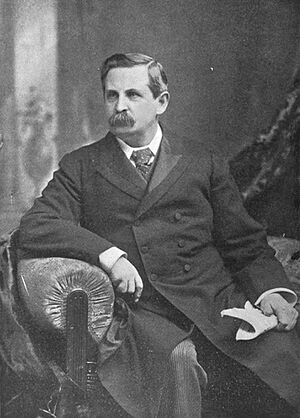Henry Austin Dobson facts for kids
Henry Austin Dobson (born January 18, 1840 – died September 2, 1921), often known as Austin Dobson, was an English poet and essayist. He was known for his charming poems and detailed writings about the 18th century.
Contents
Life of Austin Dobson
Austin Dobson was born in Plymouth, England. He was the oldest son of George Clarisse Dobson, a civil engineer. When he was about eight years old, his family moved to Holyhead, and he went to school in Beaumaris. He also studied in Coventry, England, and Strasbourg, France.
At 16, he planned to become a civil engineer, like his father. However, in 1856, he started working at the Board of Trade, a government department. He slowly moved up the ranks, eventually becoming a principal in the harbour department. He retired from this job in 1901.
In 1868, Austin Dobson married Frances Mary. They settled in Ealing, a town in England. He passed away in 1921 and was buried in the Westminster Cemetery in Hanwell.
His Writings and Poetry
Even though he had a steady job, Austin Dobson became famous as a poet and writer. He started writing original poems and stories around 1864. Many people noticed how mature his early works were.
Early Poems and Magazines
In 1868, a magazine called St Paul's gave Dobson a chance to share his work. He contributed many poems, including "Tu Quoque" and "A Gentleman of the Old School." Some of his poems were even written to go along with illustrations.
By 1873, Dobson had enough poems for a book. He published Vignettes in Rhyme, which quickly became popular. Famous writers like George Eliot praised his work.
Trying New Poetic Forms
During this time, poets were experimenting with new ways to write. Dobson was at the forefront of this movement. In 1876, he helped introduce French poetry forms like the triolet, ballade, rondel, and rondeau into English poetry. His second book, Proverbs in Porcelain, published in 1877, showed off these new styles.
Focus on the 18th Century
In 1883, Dobson published Old-World Idylls. This book showed his growing love for the 18th century. Poems like "The Ballad of Beau Brocade" brought the spirit of that era back to life. His poems often had a strong visual quality, like paintings.
His next poetry collection, At the Sign of the Lyre (1885), had a wide variety of poems. It included lively pieces like "Ladies of St James's" and touching poems such as "A Revolutionary Relic." He also wrote "Fables of Literature and Art," which were inspired by the writer John Gay.
Later Prose Works
After 1885, Dobson focused mostly on writing non-fiction. He wrote many biographies about his favorite 18th-century writers. These included books about Henry Fielding, Thomas Bewick, and William Hogarth. His writings were known for being well-researched and beautifully written.
In 1902, the University of Edinburgh gave Austin Dobson an honorary degree. His words even inspired a song by the band Industrial Frost in 2005.





